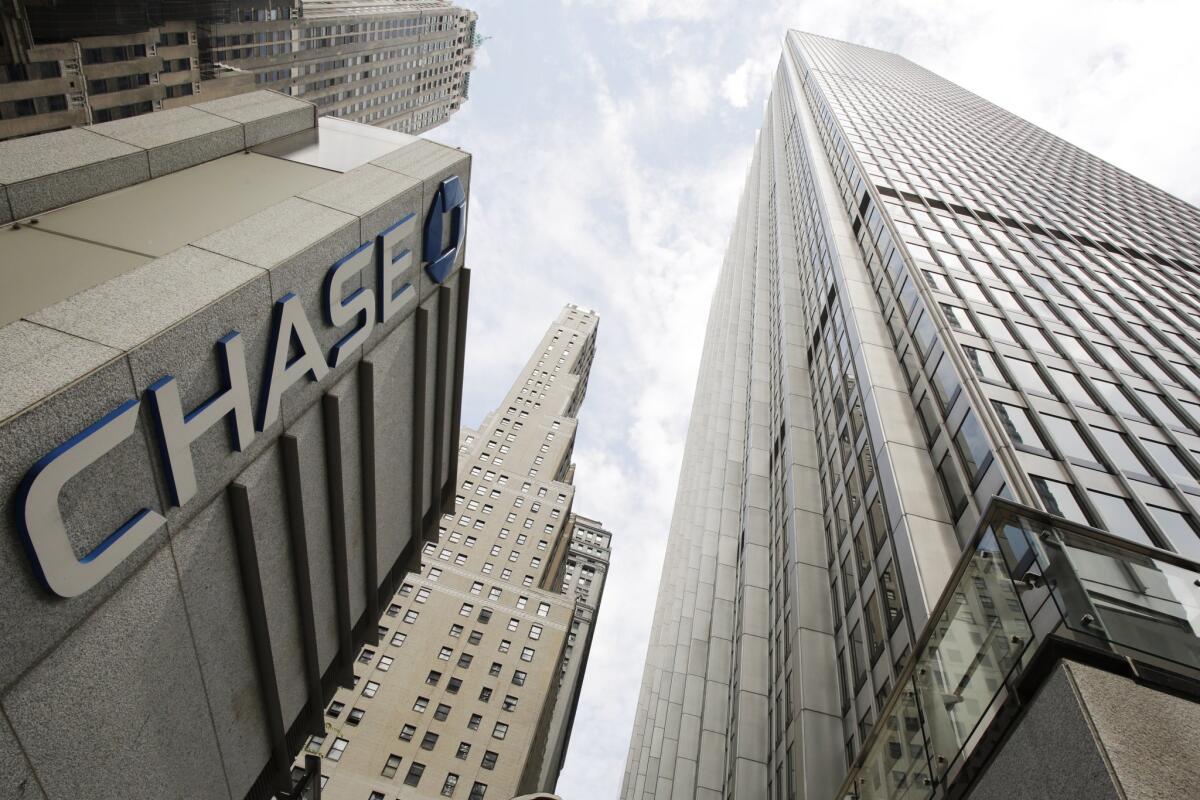Fed directs 8 biggest banks to hold extra capital

JPMorgan Chase is the only major bank that doesn’t already meet new capital requirements proposed by the Federal Reserve.
- Share via
Federal regulators are directing the eight biggest U.S. banks to hold capital at levels above industry requirements to cushion against unexpected losses and reduce the chances of future taxpayer bailouts.
The Federal Reserve’s action Monday means the eight banks together will be required to shore up their financial bases with about $200 billion in additional capital. The requirements also are aimed at encouraging the Wall Street mega-banks to shrink so they pose less risk to the financial system. The banks include JPMorgan Chase, Citigroup and Bank of America.
Most of the banks have already put away the additional capital. JPMorgan is the only one that doesn’t already meet the requirements, which will be phased in from 2016 through 2018 and take full effect on Jan. 1, 2019. It currently falls about $12.5 billion short, according to Fed officials.
The Fed governors voted 5-0 at a public meeting to impose the so-called “capital surcharges” on the eight banks.
The extra capital requirements will increase in proportion to how risky the regulators deem a bank to be. A key risk factor will be how much a bank relies on short-term funding markets to borrow from other banks. Those markets seized up during the 2008 financial crisis.
The government stepped in during the crisis with hundreds of billions of dollars in bailouts of the big Wall Street banks as well as hundreds of smaller U.S. banks.
The Fed governors also unanimously adopted standards for new supervision by the Fed of General Electric Co.’s finance arm, which will be subject to rules similar to those governing big banks. Most of the rules would take effect by Jan. 1, 2018. GE Capital Corp. was labeled two years ago as a potential threat to the financial system by a special council of regulators.
That label of a “systemically important” nonbank financial company meant that GE Capital had to increase its capital cushion, limit its use of borrowed money and submit to inspections by examiners. The company came under the Fed’s supervision.
The government guaranteed up to $139 billion of GE Capital’s debt during the crisis. GE Capital issued about $51 billion in long-term debt and $17 billion in short-term debt with government backing. The company, based in Norwalk, Connecticut, issues a range of loans for consumers and companies. It had struggled during the crisis due to mounting defaults and losses on loans in areas like credit cards, commercial real estate and heavy equipment.
The new Fed standards for supervision could be temporary because parent General Electric, one of the world’s biggest companies, has been selling off GE Capital’s businesses. That could lead to the “systemically important” designation being removed as the financial company shrinks. GE has announced a plan to divest about $200 billion in GE Capital assets by 2018, pulling the parent company closer to its industrial roots and away from finance.
The Financial Stability Oversight Council, which is headed by Treasury Secretary Jacob Lew and includes other top regulators such as Federal Reserve Chair Janet Yellen, hasn’t yet reversed its ruling. If that happens, the Fed’s action will be cancelled.
The other banks subject to the capital requirements are Goldman Sachs, Wells Fargo, Morgan Stanley, Bank of New York Mellon and State Street Bank.
Stricter capital requirements for banks were mandated by Congress after the financial crisis, which struck in the fall of 2008 and ignited the worst economic downturn since the Great Depression.
In recent years, the Fed and other regulators have put into effect a series of rules for banks to increase their capital buffers, as required by the 2010 financial overhaul law. The new additional layer of requirements for the biggest banks also exceeds the levels mandated by international regulators.
More to Read
Inside the business of entertainment
The Wide Shot brings you news, analysis and insights on everything from streaming wars to production — and what it all means for the future.
You may occasionally receive promotional content from the Los Angeles Times.









